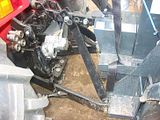pycoed
Silver Member
- Joined
- Mar 28, 2007
- Messages
- 144
- Location
- West Wales UK
- Tractor
- Zetor 7045; Wheelhorses C121, C101, A8;Cushman Turf truckster
I have a Long 445DT which comes fitted with a factory remote hydraulic valve intended to operate a double acting cylinder via two quick connects at the rear. Down feeds one connect & up feeds the other. It has previously been modified so that the lever-down valve outlet is piped to a spool block operating the front loader & a return pipe from that spool block delivers oil back to the transmission/tank. The lever-up outlet remains connected to a single rear quick connect.
So, to operate the FEL controls I have to hold down the factory valve lever with my right calf so that the FEL controls work, This is a bit inconvenient , but I could live with that. Now it starts to get a little more complex!...
I have just added a backhoe, originally a subframe type for some unknown tractor. The subframe was not suitable for my 445 'cos it fouled the 4 WD output & I wasn't keen on the hassle of fitting & removing the subframe.
I chopped & welded the subframe & welded on some mounts for a three point mounting, which seems fine & is easy to fit & remove. I have no rocky ground or heavy digging I need the backhoe for ditch clearing & general drainage work in a marshy area.
The backhoe uses the tractor hydraulics i.e. one pressure connection to the spool block & a return to tank. I used the existing quick connect for the pressure & added another for the return to transmission/tank. Now holding the remote lever up with a bungee, the backhoe controls all work well, except I have a problem: I am relying on the TPH arms to remain in a set position so that I can use the backhoe leg jacks to firm up the setup for digging. However when I down the boom, dipper or bucket to start a dig the TPH arms move up.
I have deduced that the TPH arms float if the remote valve is in use. Is this a correct deduction? Position control works fine when using a brush hog /mower/ rake etc so I think the TPH is OK. Can anyone suggest a way around this, short of using a PTO pump & separate tank for the backhoe hydraulics?
So, to operate the FEL controls I have to hold down the factory valve lever with my right calf so that the FEL controls work, This is a bit inconvenient , but I could live with that. Now it starts to get a little more complex!...
I have just added a backhoe, originally a subframe type for some unknown tractor. The subframe was not suitable for my 445 'cos it fouled the 4 WD output & I wasn't keen on the hassle of fitting & removing the subframe.
I chopped & welded the subframe & welded on some mounts for a three point mounting, which seems fine & is easy to fit & remove. I have no rocky ground or heavy digging I need the backhoe for ditch clearing & general drainage work in a marshy area.
The backhoe uses the tractor hydraulics i.e. one pressure connection to the spool block & a return to tank. I used the existing quick connect for the pressure & added another for the return to transmission/tank. Now holding the remote lever up with a bungee, the backhoe controls all work well, except I have a problem: I am relying on the TPH arms to remain in a set position so that I can use the backhoe leg jacks to firm up the setup for digging. However when I down the boom, dipper or bucket to start a dig the TPH arms move up.
I have deduced that the TPH arms float if the remote valve is in use. Is this a correct deduction? Position control works fine when using a brush hog /mower/ rake etc so I think the TPH is OK. Can anyone suggest a way around this, short of using a PTO pump & separate tank for the backhoe hydraulics?


